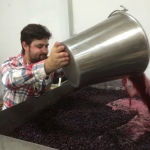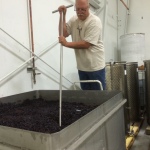Read Part 4 of our Starting J. Cage Cellars – A Family Winery Series
Much to my naive surprise, learning to be a winemaker (for our new J. Cage Cellars label) and seeking winemaking advice has turned out to be much like my first days of fatherhood and seeking child rearing advice. Even the most artful winemakers hold deeply seeded conflicting opinions. As my friend Kurt Beitler of Bohème Wines told me, “Roger…What do you get when two winemakers are in a room together?…Four opinions.”
 I recall from my early days as a father asking different parents I respected about child rearing philosophies and techniques. As I found with winemaking, there was an inconsistency of heartfelt answers. Let the child bond by sleeping in bed with you. The child should learn independence by sleeping in another room. Let the child set their own schedule. If your child sets their own schedule, you’ll have an undisciplined child and you’ll get no rest…It’s all enough to leave your head spinning like the child, Regan, in the 1973 film The Exorcist.
I recall from my early days as a father asking different parents I respected about child rearing philosophies and techniques. As I found with winemaking, there was an inconsistency of heartfelt answers. Let the child bond by sleeping in bed with you. The child should learn independence by sleeping in another room. Let the child set their own schedule. If your child sets their own schedule, you’ll have an undisciplined child and you’ll get no rest…It’s all enough to leave your head spinning like the child, Regan, in the 1973 film The Exorcist.
Even though I had spent quite a bit of time reading about the art of winemaking, when the time came for decision making, I relied on a core group of respected winemaker friends who were happy to offer solid advice. I had assumed incorrectly, that since they produced wines in a similar style, their techniques would be nearly the same and I would have a simple plan to follow. I could not have been more wrong. Not only are many of their opinions deeply held, I was told that if I followed another’s advice…it could end badly. Like Regan…my head was and is still, though to a much lesser extent, spinning.
Each decision made by a winemaker ultimately affects the character and flavor of the wine to some extent. The biggest decision is when to pick your fruit because once its picked, there is no turning back. Different levels of ripeness produce different flavors and levels of alcohol. A later pick with higher sugars may provide greater richness of flavor but those same sugars are converted to an alcohol level so high that the wine can taste hot or out of balance. There are ways to manipulate the juice (adding water) or wine (using technology) to reduce alcohol, but that was not the direction we wanted to go.
Other decisions include what yeast to use or to just let the grapes start fermentation with the native yeasts living on the berry skin. Native yeasts can produce nuanced flavors but are risky because you never know if there is enough yeast to complete the fermentation. A stuck fermentation, as I have been told, can be a big problem. On a side note, many years ago a stuck fermentation with a Zinfandel rosé resulted in Sutter Home White Zinfandel and a new wine craze began. But since I am not looking to start a craze or cope with a stuck fermentation, we choose commercial yeasts. Commercial wine yeasts add to the wine’s flavors and mouth-feel in different ways, like spice in a pie. There are a lot to chose from and different winemakers swear by different yeast strains for the same wine variety.
Then there are also fermentation techniques to choose between. How cool a fermentation for white wines and how hot to let a red wine fermentation go. Red wines are allowed to ferment at higher temperatures to extract color and flavor from the skins. Red wines normally go through a secondary fermentation called malolactic fermentation. This converts the tart, green apple like, malic acid to the creamier lactic acid you find in cheese and milk. With white wine, the winemaker may or may not choose to introduce malolactic fermentation. Strong opinions on this abound, too. Ultimately I chose no secondary fermentation on the Sauvignon Blanc but we will put part of our Viognier through malo to soften the mouth-feel.
So many decisions for this fledgling winemaker and there are even more I won’t bore you with, such as how many times each day to punch-down the skins of our Pinot Noir into the fermenting juice to add oxygen for fermenting yeast, improve color and flavor.
At first the decisions and choices were overwhelming like long ago with our new baby who cried for no apparent reason while I tried helplessly to offer comfort and happiness. But like any new dad, I have found my stride and learned to evaluate the helpful advice from those winemakers who have far greater experience than me. I’ve learned that with winemaking, like child rearing, there are many right answers and only a few absolutes.
In the end, I’ve begun to trust my instincts and all, with the wines, is going well. The days of my spinning winemaker exorcist head seem to have come to an end, at least for now.
Please read my other posts in the Starting J. Cage Cellars – A Family Winery Series

